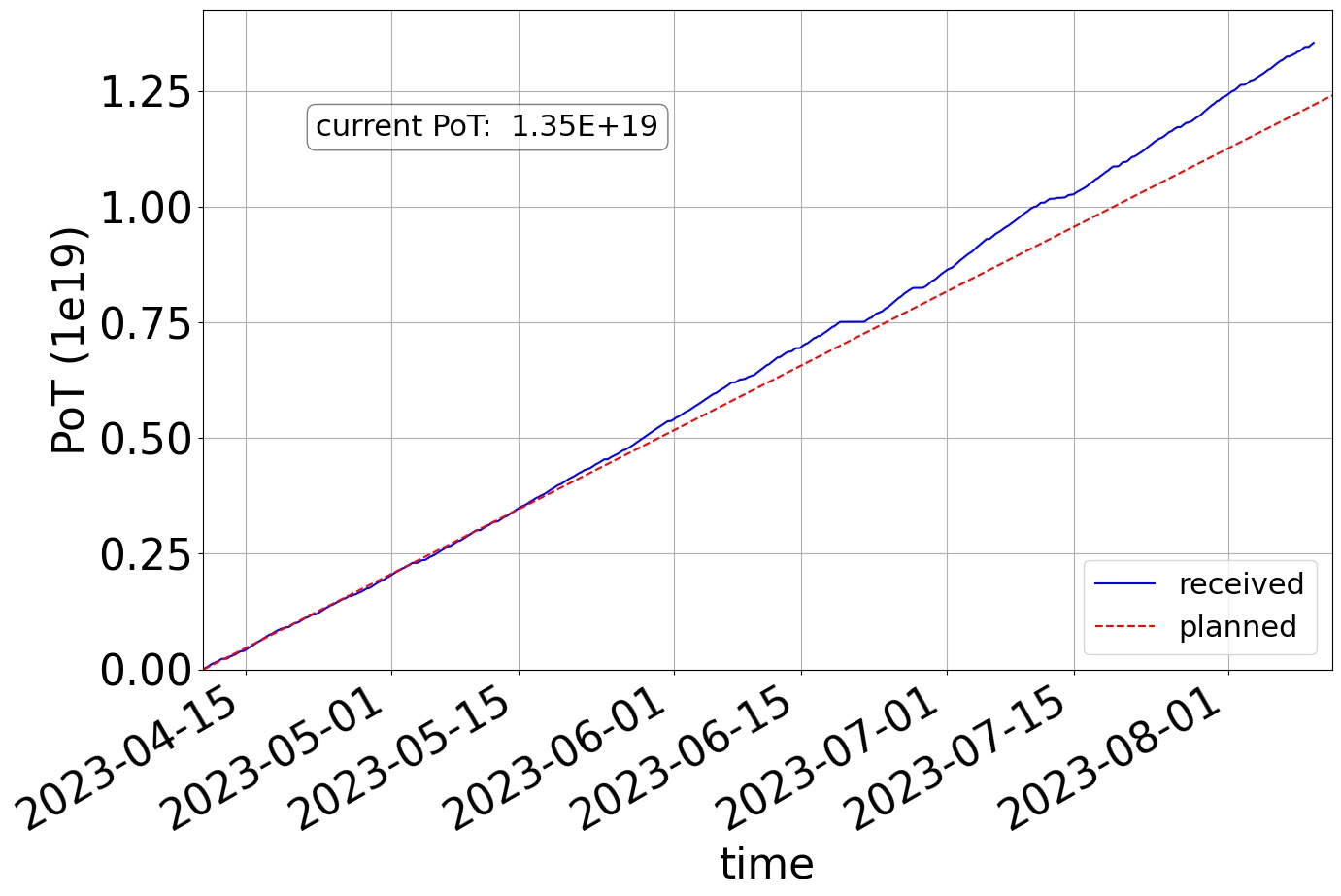
The agenda for this meeting is based upon user schedule 1.7.1, please cf. here. Please note the current injector schedule which contains information about MDs, Technical stops, etc. and can be found here.
Next user meeting:
For week 33 on Thursday August 17th, 2023 10:30 CEST
Meeting room: 874/1-011 (CERN)
Changes to User Schedule since 1.7.1 (will be reflected in 1.8)
PS and SPS Physics Coordination:
August 4 to August 14: Martin Jaekel
August 15 to August 20: Dragoslav Lazic
August 20 to August 23: Martin Jaekel
EURO-LABS TA:
Email to all requestors have been sent out:
Possibility to test one scheduled, dedicated AWAKE run
Currently no request. Will be taken up later.
Week 32
Week 33
Week 34:
Wobbling change August 10 (Thu) to August 14 (Mon):
T2 = 50
T4 = 48 / T10 = 28 27 (corrected during the meeting)
T6 = 35
Addendum Friday 10h (M.J.): To profit from the PSB stop (leak search), the PS intervention on a 20 MHz and 40 MHz cavity has been moved to Monday morning (Originally proposed for Tuesday 9h). The wobbling change on Monday has therefore been moved by one hour to around 10h (from 9h).
NOTE
It was decided to follow up on the issue with the power cut impact on the operation of the phones within the realm of the TIOC meetings: Major Fault 144190 -https://edms.cern.ch/ui/file/2926903/1/TIOC_09_08_2023.pdf
The importance of the issue was emphasised, Laza reminded everybody that GSM reception is better outside of the ENH1 hall, facing towards the Jura side, in case of emergency and no other means of communication.
Progressing well with physics programme:
Proton beam:

T09: No issues. MDX magnet installed in the user zone. T09.DHZ045 is disconnected until Aug 16th to use its power supply for the above. Changes will be reverted back next week on Wednesday.
T10: No issues.
T11: No user.
Excellent week, no issue with operation. Weekly intensity level among the highest delivered to T8 in 2023, thanks! :) (2.4e16 p/w, see plot below). Beam alignment and center on both X- and Y-axis, under control (The number of spills centered within +/- 2mm on the horizontal plane decreased a bit w.r.t. the previous weeks [~86%]).

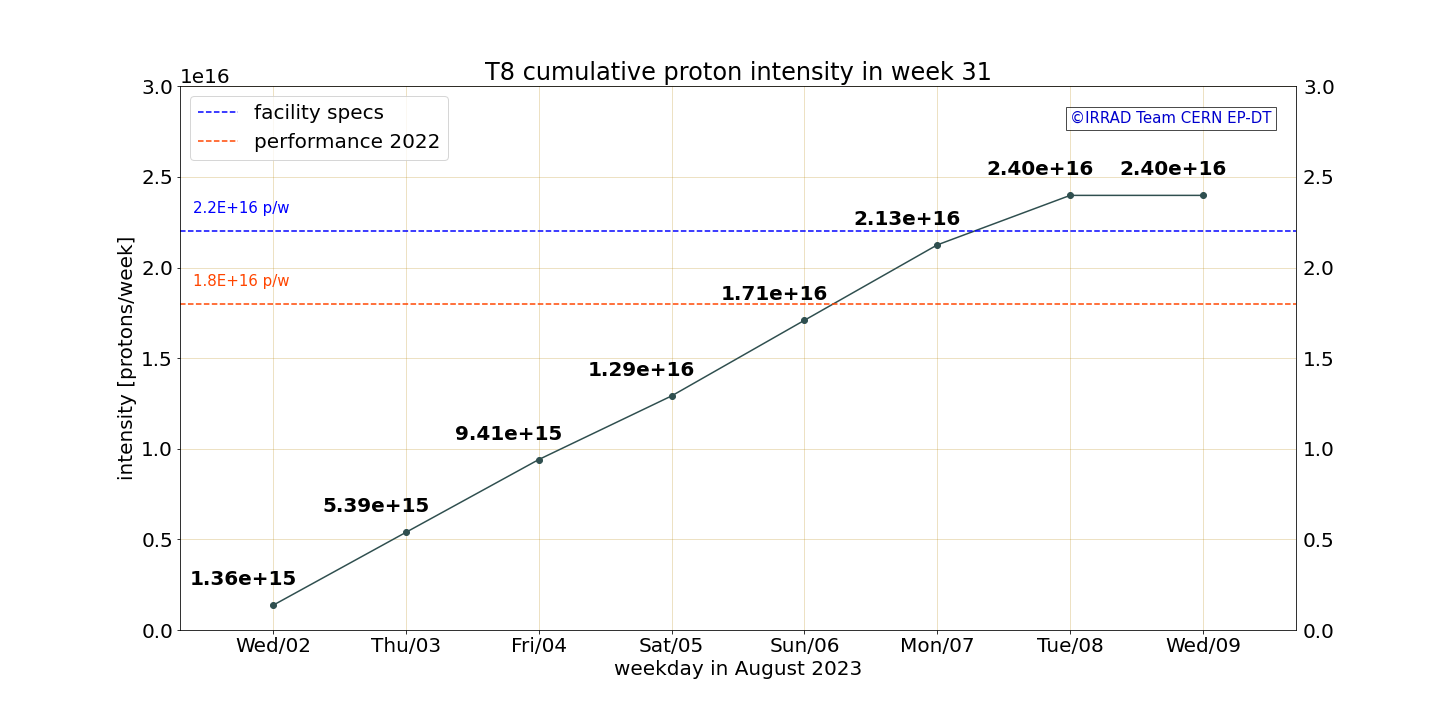
During the access on Wednesday, we exchanged the dosimetry and replaced samples for most of the long-term users: TE-MSC [including N2 experiment], ATLAS ITk Pixel [scanning table]. ATLAS HGTD, CMS Pixel and SY-BI experiment (setup with optic fibers) completed. CMS Pixel and SY-BI coming back in the coming weeks. In CHARM we modified BE-CEM and TE-MPE setups. Beam back around 11:30.
Upcoming access, next week.
We have 2 weeks of beamtime (August 2nd
- August 16th
)
During the first week we aligned our detectors, and tested different beam configurations
We calibrated our calorimeter, which showed very good linearity in the range 1 - 15 GeV. Eventually we find out that the sunlight coming from the ceil windows increased the baseline. We fixed by light shielding the PMTs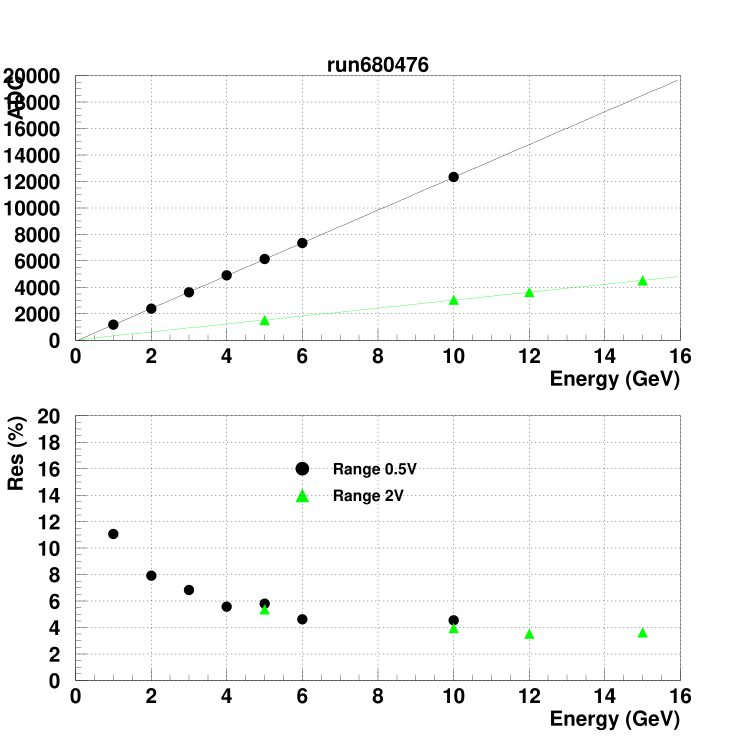
We concluded yesterday the first week by fully characterizing our PWO crystal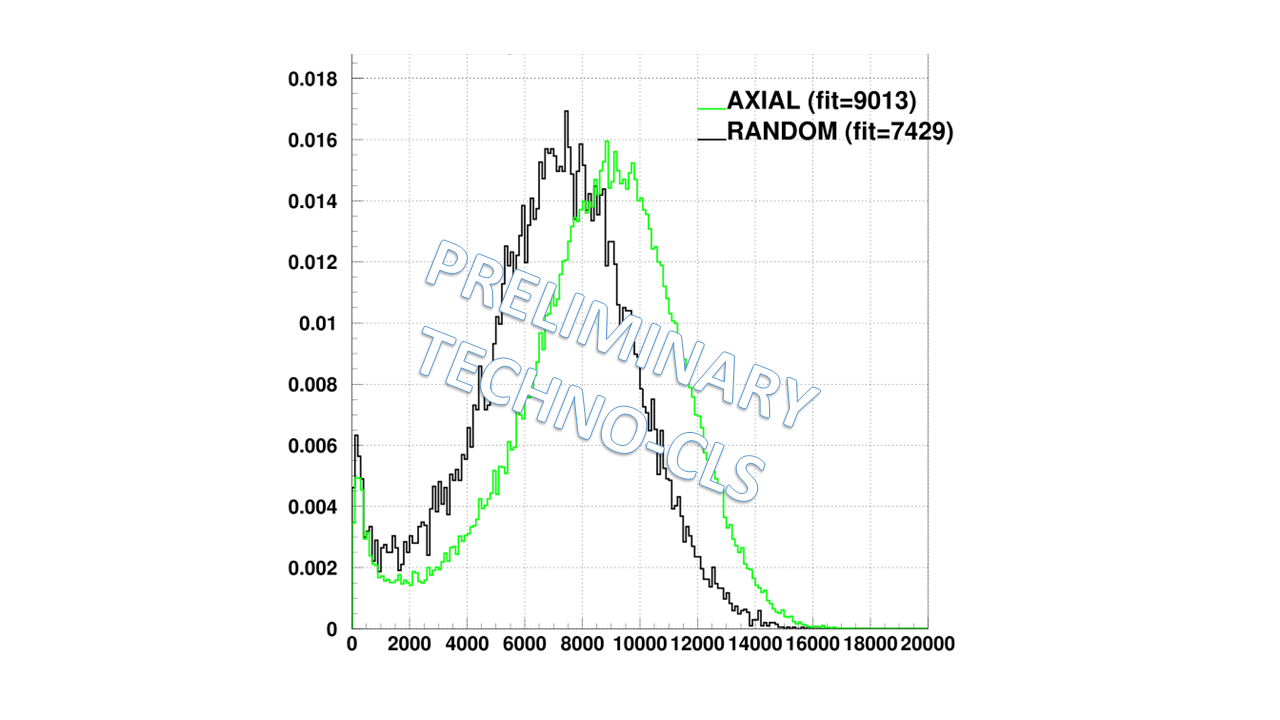
Yesterday a bending dipole magnet was installed in our area
We plan to test a new tungstate crystal for a positron source: the magnet is for swiping away charged particle, and an active photon converter (APC) is employed to detect the increase in the photon production
Very thanks to Dipanwita, Aboubakr and all the CERN staff who help us during our beamtests

Preparing set-up in the lab, so far so good
Agreed with Maarten to to stop the beam on Wednesday for intervention on the beam line
Proton beam delivery: very reliable
Daily activities:
Plan for ongoing week:
T4 wobbling change Thursday 10th at 16:00, affecting H6, H8, and P42. Both H6 and H8 will have negative beams (-120/-300 GeV/c for H6/H8). Switch back planned on Monday 14th at 09:00. Request to avoid access to H6, H8, and P42 during this time for beam tuning.
H2: Issues with the VTPC vacuum. Followed up by cooling team (EN-CV). Issue with “moving” beam still present and not understood - Power supply group (SY/EPC) is following up and there will be a dedicated meeting on Thursday.
H4: Smooth operation.
H6: Normal operation last week. CEDAR removed from beamline for a change of the internal optics and vacuum in its place.
H8: Smooth operation.
M2: The spectrometer magnet MS2 for NA64mu had some cooling temperature errors on Tuesday but could be fixed with resets. Smooth operation otherwise. Changeover ongoing to AMBER and MUonE.
P42/K12: Good operation without issues. Since the MD yesterday, the transmission to T10 is a bit lower than before, which made a slight adjustment of the T4 intensity necessary. Lowering the intensity to 22 units on T10 as requested by NA62 is scheduled for the same time as the wobbling change.
Successful beam run, 19 days smooth data taking, was recorded around 71k spills.
The first week we shared beam time with Amber collaboration, and used for commissioning and detectors calibration, alignment and trigger tuning. Thanks Amber colleagues for useful cooperation.
We measured a hadron contamination for 160 GeV muon beam.
The total amount the muons on target were recorded
1.8x10^11.
The dismounting of NA64mu setup should be finished today.
Thanks a lot BE-EA group, transport and magnet teams, and especially Sylvain, Dipanwita.
Since PPE 172 is currently accessible and free, we’re planning to start to install our system later today.
A proposal for a joint CMS-HERD data taking in H4 during weeks 37-38 is presented. The HERD detector will be mounted in the back of PPE134 beam area, and get electron beam when CMS will not be in data taking (e.g. during debugging) and moved out of beam. A minimum integrated data taking time of 1 day is needed for HERD. The proposal will be approved if there are no objections from beam physicist and from TSO (for needed equipment).
Comment from the Physics Coordination : Pending the approval of the beam physisist and the infrastructure, it has beeen agreed that HERD could take part parasitic together with CMS HGCAL. An approximate goal of 3 x 8h shift is envisaged for HERD.
We installed detector, electronics and connect the cables to control room.
We had the safety inspection yesterday at 4:30 and being operational since 6 pm yesterday
this morning we had the final alignement by Michael L team, many thanks, we can start the scanning of the detector with the precicion expected +/- 5 mm (current horiz beam)
all beam files uploaded by N. Charitonidis, Thank you.
currently we are working on the trigger and we will start the detector calibration.
I removed the ITk pixel installation Wednesday morning. There was a small leak on the secodnary cooling circuit so it took a bit more time to clean a small quantity of oil from inside the cold box. Secondary cooling circuit removed as ITk strips does not need it and external connections of Julabo chiller capped to enable to use N2 pre-cooling. All material left in EHN1; 3 pieces brought into the buffer zone and TREC requested. Tracking arrival of new material for next week. All telescope systems are nominal.
We would like to thank all SPS colliques for help and support.
We had complete our program with 100, 120, 140, 180 GeV pion beam.
Mainly 180 GeV pion beam was used.
In total, 57 Runs and 29 Scans were taken.
More than 61.5 Million event were taken.
Analysis is on going.
Hope to see you in 2024 !!!
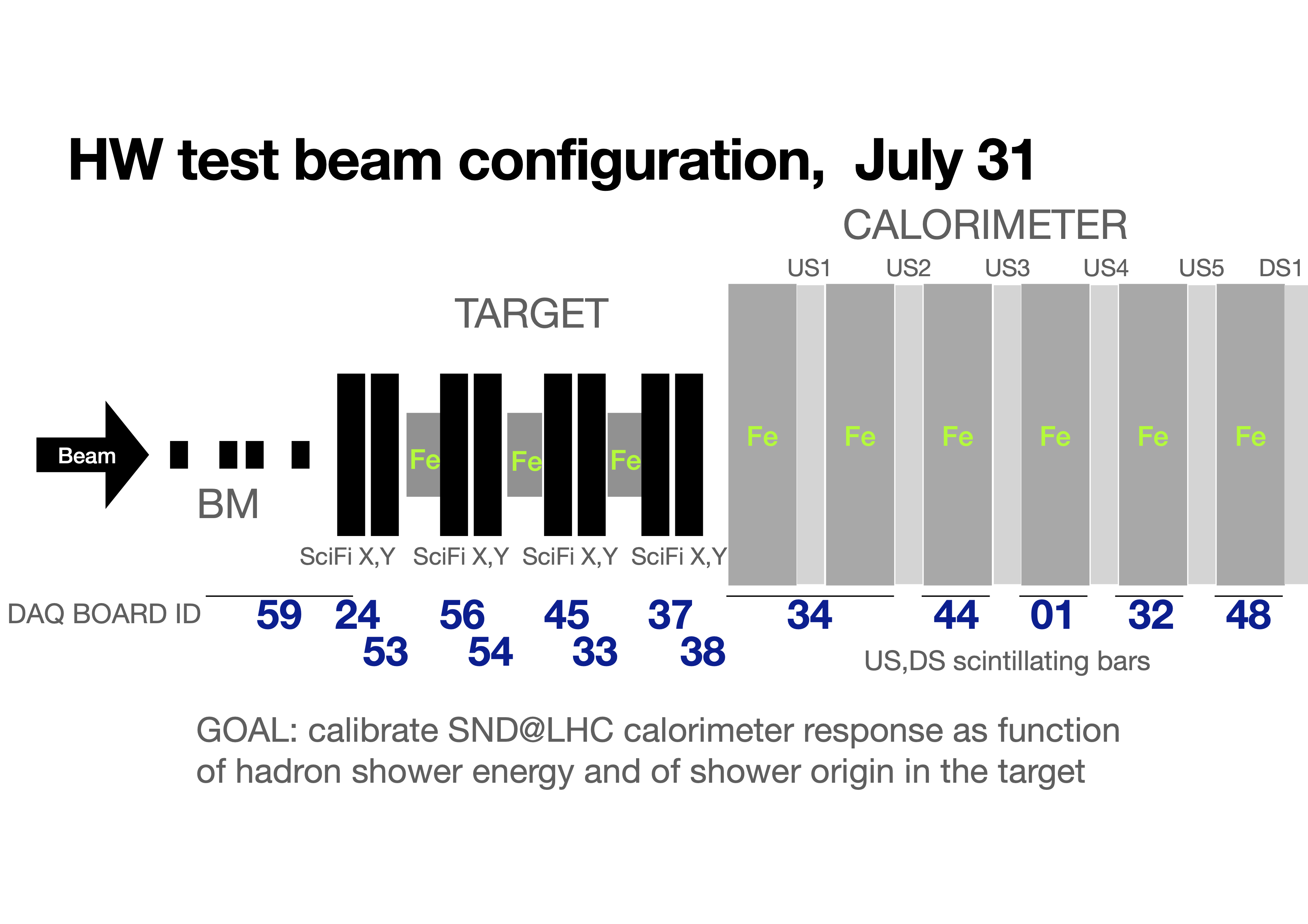
Very dense program: pion beam at 5 energies (100,140,180,240,300 GeV) times 3 target configurations. Aim at high statistical accuracy. Handicap: the RO is slowish.
Thanks to QFIB colleagues and Maarten van Dijk, we were able to collect data for tuning the RO thresholds and understand our DAQ rate limitations.
Wednesday 9 in the evening/night Marteen prepared beam files for 100,140,180 GeV optimized for our experiment: transverse beam size 2 to 4 cm, rate of ~4K / spill. After a few iterations we were extremely happy with the result. In data taking since then. We finished the 3 target walls x 100 GeV program, and we switched to 140 GeV. And we’ll collect 180 GeV before the beam polarity change, agreed for the mid afternoon.
SND@LHC & LHCb : Proposal to install a combine setup in PPE168 for parasitic use between the SND and LHCb bean time. Approved in agreement with Maarten for H8. Pending requirements : beam request and activity description & ISIEC.

First CEDAR tests with new optics completed successfully in parasitic mode, and CEDAR removed from beamline for a change of the internal optics. CEDAR parasitic request for weeks 35/36 vs. previous request of 34/35 to allow more time for change of optics.
We plan to perform the position resolution studies for our Mini.PAN spectrometer using high energy hadron beam. The spectrometer is installed on the remotely controlled rotating stage to perform angular scans as well. It will be the first beamtest with all subdetectors installed and synhronized.
Minutes by the respective speakers, edited by M. Jaekel, E. B. Holzer and M. Schwinzerl